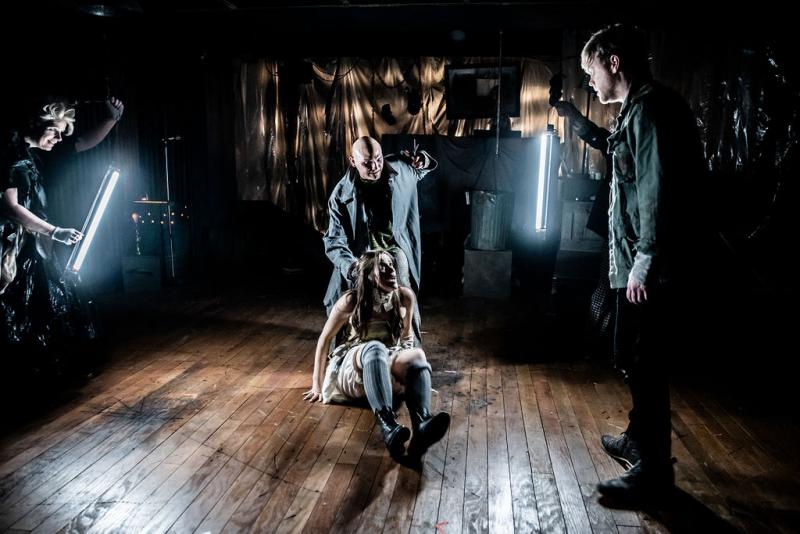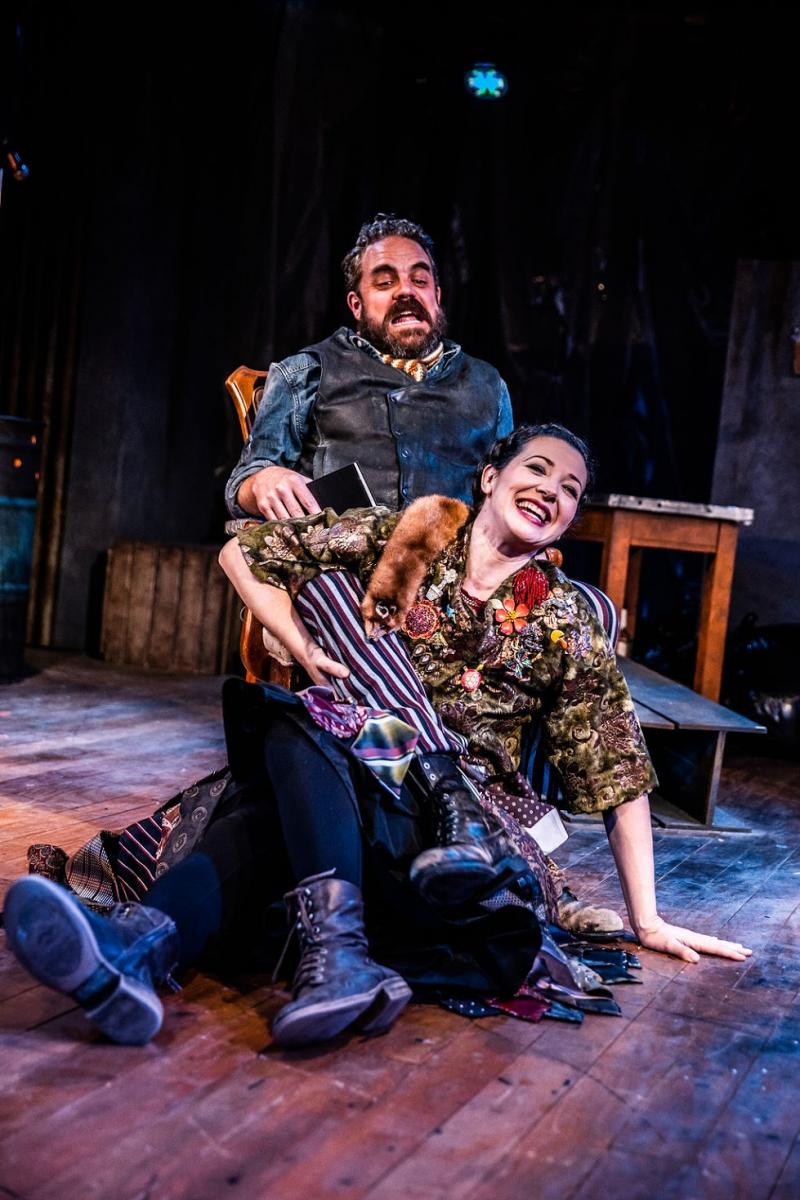Review: SWEENEY TODD Serves Up an Exhilarating Feast at Circle Theatre

"Musicals," Stephen Sondheim once wrote, "are, by nature, theatrical, meaning poetic, meaning having to move the audience's imagination and create a suspension of disbelief, by which I mean there's no fourth wall." Perhaps it is for this reason that Sondheim's musicals open themselves up to those performers and artists willing to take big creative risks and invite audiences into those risks at the same time, collaborating with one another to create a performance unlike any other that came before it and setting a kind of standard for all that may come after.
This ideal mixture of terrifying risk and breathtaking entertainment finds its exhilarating apotheosis in Circle Theatre's production of SWEENEY TODD, running now through July 13.
SWEENEY TODD: The Demon Barber of Fleet Street, with book by Hugh Wheeler, is Sondheim's 1979 musical that reaches Shakespearean heights in its operatic tale of passion and revenge. After years spent in exile, Sweeney Todd returns to London to seek justice from those authorities who wrongfully sent him away from his wife and daughter. Along the way, he's assisted by the pie shop owner Mrs. Lovett, who has a few creative ideas about what to do with Sweeney's victims once the bodies start piling up.
Under the direction of Joel Ferrell, Circle Theatre's production borrows several creative decisions from the musical's 2005 Broadway revival, including using a barebones cast of eight performers who play multiple roles as well as a few instruments. While these choices may be the revival's, the rest of the production's aesthetic is entirely original, upending any expectations of what this show ought to be to stunning effect. Ferrell uses the tight quarters of the theatre's thrust space to the show's advantage, sending the cast out into the audience from the beginning in ways that bring the fourth wall almost literally crashing down (more on the set later, though). Furthermore, Ferrell's staging is some of the cleverest and most inventive that audiences are likely to see this season, using a small array of hinged boxes, moving platforms, and bare light fixtures in ways that allow actors to create imaginative locales from all over nineteenth century London while switching from scene to scene without losing an iota of momentum.
Ferrell's small ensemble cast of eight proves itself more than up to the task of matching his imagination and energy, switching roles from one moment to the next, creating distinct personalities while maintaining a playfully ominous atmosphere that entirely envelops the audience. Mary Gilbreath Grim and Alex Heika are especially adept in this regard, since they are the performers most often called upon to put on different roles. Grim switches back and forth from heartbreaking pathos to hilarious humor as a crazed Beggar Woman and the hysterical Italian barber Pirelli. Heika is delightfully demented as the Beadle and Jonas Fogg, finding humor in his characters' terrifying unpredictability while treating audiences to his eerily sweet falsetto vocals in numbers such as "Ladies in Their Sensitivities."
 Speaking of the musical's "villains" (no one comes away clean in this show), Randy Pearlman shows off the full range of his dramatic expertise as Judge Turpin, the man most directly responsible for Sweeney's misfortune. Pearlman's Turpin is intensely sinister without ever becoming a moustache-twirling stereotype. In fact, the scariest part of his characterization is how nonchalantly his Turpin excuses acts of injustice, delivering death sentences with deadpan delivery before making sweet overtures to his ward, Johanna. Thankfully, Pearlman is given a few opportunities to make use of his comedic skills as well, playing several of Sweeney's foolishly oblivious victims over the course of just one number.
Speaking of the musical's "villains" (no one comes away clean in this show), Randy Pearlman shows off the full range of his dramatic expertise as Judge Turpin, the man most directly responsible for Sweeney's misfortune. Pearlman's Turpin is intensely sinister without ever becoming a moustache-twirling stereotype. In fact, the scariest part of his characterization is how nonchalantly his Turpin excuses acts of injustice, delivering death sentences with deadpan delivery before making sweet overtures to his ward, Johanna. Thankfully, Pearlman is given a few opportunities to make use of his comedic skills as well, playing several of Sweeney's foolishly oblivious victims over the course of just one number.
Turpin's authoritativeness is contrasted by the youthful innocence of Tobias Ragg, an urchin taken in by Mrs. Lovett during the course of the show and played by Alejandro Saucedo. Saucedo portrays Tobias with an endearing sweetness and a beautiful tenor voice that nicely contrasts with the intimidating brutality of the other characters. However, Saucedo also finds moments where his innocence begins to crack, moments where he begins to see the cruel world for what it really is, cleverly foreshadowing the show's gut-wrenching final scene. He brings a tragic, almost frantic earnestness to his rendition of one of the show's most famous numbers, "Not While I'm Around," that beautifully illustrates the fine line between blissful ignorance and cynical wisdom.
The show is not without its share of love and beauty, though, and a significant portion of the plot focuses on the attempts of the sailor Anthony (Ian Ferguson) to rescue Johanna (Carly Wheeler) from Turpin's home. In dingy clothes and smeared make-up, Ferguson and Wheeler may not look like conventional romantic leads, but both performers take the stage with a sincerity and charisma that will have patrons hoping against hope for their success. It's only a slight cliché to say that Wheeler sings as beautifully as a caged bird, bringing a similar level of frenzied despair to her performance as well in captivating numbers such as "Green Finch and Linnet Bird" and "Kiss Me." For his part, Ferguson is as winsome as the lead singer of a rock band, charming both Johanna and audiences with his beautifully emotional vocals and expert guitar-playing skills. His acoustic rendition of the first act ballad, "Johanna," is probably the finest this reviewer has yet to experience.
This incredibly talented ensemble is rounded out by the show's leads, with Max Hartman playing Sweeney and Sarah Gay portraying Mrs. Lovett. In a role made famous by the likes of Angela Lansberry and Patti LuPone, Gay completely owns the part as her own, fusing the elements of charm and terror that make up the rest of the production. Sondheim's scores prove difficult for even the most seasoned of performers, but Gay navigates his most twisted turns of phrases with seemingly effortless skill, modulating her dynamics and delivery in ways that make her lyrics sound as natural as everyday conversation in numbers such as "God, That's Good" and "By the Sea." She maintains a volatile chemistry with Hartman throughout the show that brings excitement and uncertainty to the relationship. Gay's warmth as Lovett makes it impossible for Hartman's Sweeney to escape her embraces, in the same way that even the meanest of animals will slink toward an outstretched handful of food.
 The intimacy of the performance space informs much of Hartman's portrayal of Sweeney, allowing him to show the value of subtlety in a role that can too easily blow up in a smokestack of melodrama. Hartman delivers his every line and moves every sinew of his body with the cold precision of a calculating murderer, developing a controlled bearing for the character that makes it all the more refreshing when Hartman lets his guard down, especially around Mrs. Lovett. Moments such as these humanize Sweeney, and audiences may very well find themselves rooting for the character even if his methods may terrify them. There are a few moments in which Hartman's performance is a little too understated, especially in the show's final moments, though this is understandable when one considers how demanding the role is and that the actor must maintain the quality of his performance over the next month. All in all, there is no denying that Hartman is an expert in his craft.
The intimacy of the performance space informs much of Hartman's portrayal of Sweeney, allowing him to show the value of subtlety in a role that can too easily blow up in a smokestack of melodrama. Hartman delivers his every line and moves every sinew of his body with the cold precision of a calculating murderer, developing a controlled bearing for the character that makes it all the more refreshing when Hartman lets his guard down, especially around Mrs. Lovett. Moments such as these humanize Sweeney, and audiences may very well find themselves rooting for the character even if his methods may terrify them. There are a few moments in which Hartman's performance is a little too understated, especially in the show's final moments, though this is understandable when one considers how demanding the role is and that the actor must maintain the quality of his performance over the next month. All in all, there is no denying that Hartman is an expert in his craft.
This SWEENEY TODD would be thrilling enough with just the assembled cast under Ferrell's direction, but the efforts of all are greatly amplified by the rest of the creative team. In addition to playing Anthony, Ferguson pulls double duty as the show's music director with impressive results. Keeping in mind the production's minimal orchestrations (the only instrument constantly in play is a single upright piano), Ferguson uses his cast's vocal parts to achieve different effects such as the crashing of cymbals, the humming of strings, and the echoing of multiple ghostly voices. All of this takes place within the realm of Bob Lavallee's set and Amanda West's lighting design. Lavallee is no doubt responsible for the space's moving platforms, but he also creates much of the show's chaotic and foreboding atmosphere in the theatre's basement. The rantings of a madman are scrawled all over corrugated metal walls and iron columns, and I-beams jut from the back wall of the space as well as from broken ceiling tiles overhead. Combined with West's brilliant use of shadows and bare light fixtures moved and manipulated by the cast, the entire production feels as though it is taking place at the site of a crime scene or disaster that will never be cleaned up.
In his director's note in the program, Ferrell fears of what might happen if we do not pay attention to the horrors of our own world, warning audiences that "new Sweeney Todds will be forged of anguish and indifference." While only time can tell if his proclamation will come true, it is clearly evident that Mr. Ferrell and his team have forged a new SWEENEY TODD all of their own making, one that is sure to thrill audiences with its risks and creativity.
Photo Credit: TayStan Photography
Join Team BroadwayWorld
Are you an avid theatergoer? We're looking for people like you to share your thoughts and insights with our readers. Team BroadwayWorld members get access to shows to review, conduct interviews with artists, and the opportunity to meet and network with fellow theatre lovers and arts workers.
Interested? Learn more here.
Videos
